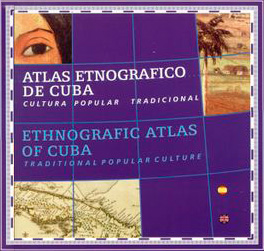Presentation

The obsolescence of CD players has made it almost impossible to consult the original multimedia of the Ethnographic Atlas of Cuba on modern devices. For this reason, the Cuban Institute of Cultural Research (ICIC) "Juan Marinello" and the Cuban Institute of Anthropology (ICAN) have decided to create this website, which facilitates access to this work of extraordinary value.
The possibility of consulting the Atlas online contributes to the development of cultural research and promotion, as well as teaching, and opens the door to its updating and enrichment. It is also a tribute to the work of the hundreds of researchers-surveyors who participated in its elaboration and of the bearers and disseminators of the values of traditional popular culture who offered their knowledge and made this work possible.
The site respects the original contents and design of the Atlas, with some minor modifications, mainly in the ways of accessing the information, adapted to the web environment. In addition, the Galleries section was added, where the user can independently consult the Atlas' Photo, Map and Video collections.
General characteristics
The Ethnographic Atlas of Cuba is the main result of a national research that involved, from the mid 1970s to the early 1990s, numerous institutions and specialists from all over the country (and some foreigners, especially from the former Soviet Union), under the direction of the then Juan Marinello Center for Research and Development of Cuban Culture and the Center for Anthropology.
The current ICIC "Juan Marinello" took advantage of the territorial structure of the national system of cultural institutions to collect information on traditional popular culture -festivals, music, rythms and dances, oral traditions, crafts- with the help of specialists based in all municipalities and the special municipality of Isla de la Juventud; reviewed by researchers at the provincial level, this information was passed on to the national team for final processing.
The actual named Cuban Institute of Anthropology undertook the study of ethnic history and carried out ethnographic expeditions to rural areas in nine provinces. These expeditions resulted in the elaboration of questionnaires that were applied by means of a national survey in 1988. The topics covered were: rural settlements, housing and auxiliary constructions, furniture and furnishings, food and beverages, agricultural work tools, modes and means of transportation, maritime fishing gear and vessels.
Part of the information collected was classified into typologies, which could be mapped and captured in maps to show the spatial distribution and historical dynamics of the various cultural manifestations studied. For this purpose, innovative methods of cartographic representation were used, with the use of cartodiagrams, cartograms and out-of-scale symbols. The cartographic work was carried out with the participation of specialists from the Tropical Geography Institute.
It is this part of the work that, due to the impossibility of being printed, would appear in digital format, edited by the two leading institutions of the project and the Center for Informatics and Systems Applied to Culture (CEISIC). It consists of a "General Introduction" and thirteen thematic sections dealing with the different aspects of popular culture mentioned, each with its introductory review. A total of 238 maps are offered, accompanied by abundant audiovisual material (1246 images, 46 videos, 96 musical fragments), as well as by a glossary that records those terms of popular culture in need of explanation.
At the same time, and up to the present, the authors of the Atlas have also published an important number of articles and individual and collective books, which include other results of this great research. As an example, we can cite, among them, the works published through the publishing house of the Juan Marinello Center: Entre brujas, pícaros y consejos (1997), and Cuba, expresión literaria oral y actualidad (1998), by María del Carmen Víctori; Forma y tradición en la artesanía popular tradicional cubana (1998), by Dennis Moreno; Del areíto y otros sones (2001), Música tradicional vueltabajera (2002), Juegos tradicionales para bebitos (2010) and Estudio sobre los cantos de cuna tradicionales cubanos (2015), by Martha Esquenazi; Fiestas y tradiciones cubanas (2003), by Virtudes Feliú; Las danzas populares tradicionales cubanas, by Nieves de Armas and Caridad Santos, and Entre señales y vaticinios. Los agüeros cubanos (2004), by the latter author. In addition, the compilation Cultura popular tradicional (1999), which gathers the introductory reviews of the Atlas sections, as well as the Léxico de la cultura popular tradicional (2016), a corrected and expanded edition of the Atlas glossary. It is also worth mentioning the texts published by the Editorial Academia and the Centro de Antropología in the 1990s, in the yearbooks Estudios Etnológicos. This last institution, together with the Institute of Ethnology and Anthropology Miklujo-Maklai, of the Russian Academy of Sciences, published in 2003, in Russian, the volume Traditional Material Culture of the Rural Population of Cuba, which gathers part of the thematic monographs of the Atlas.
Valuation
The Ethnographic Atlas of Cuba is a key work to know the traditional popular culture. It is the most comprehensive research on this subject ever projected, executed and published on the island.
It involved hundreds of actors, from the so-called bearers to researchers and workers of institutions in the capital, provinces and municipalities of the country. In this sense, it served as a school to train specialists at all levels, both in the field of cultural studies and in the handling of methods and techniques of anthropology and ethnography.
At the time the research was completed (early 1990s), the Atlas offers, in a unique and original way, a historically and geographically situated panorama of the cultural manifestations studied.
It also offers theoretical and methodological indications to continue the work of deepening these themes through new research by universities and cultural institutions.